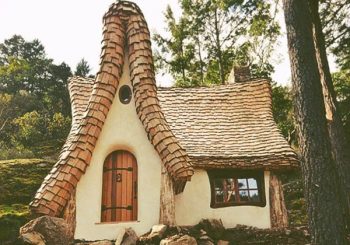 By Paul Lenda
By Paul Lenda
Guest writer for Wake Up World
The majority of humans live in the traditional boring box house. However, these days there are lots of alternatives to this dull kind of domicile. If you want to live in a more exciting home, you will want to learn about these 10 alternatives to conventional houses.
Earthships
Springing for from the imagination of the eccentric Michael Reynolds, Earthships are a type of house built with natural and recycled materials (usually cob and tires) with energy conservation in mind. These sustainable homes are specifically designed to produce their own water, power, and food.
By using natural and recycled materials, the homes are affordable yet double as works of art. Harnessing the power of the sun and wind allows for the continuous generation of free energy. Thanks to the large amount of thermal mass because of dirt-filled tires, along with passive solar heating, Earthships stay warm when it’s cold out and cool when it’s hot.

What makes Earthship really stand out is the greenhouse that is attached to it. Since it faces South, there is year-round production of fruits and vegetables. The water harvesting system that an Earthship has is integrated into the greenhouse, using greywater from the kitchen and shower to irrigate the home’s food garden.
Based on the average spending in the US for utilities and food, living in an Earthship would save you over $5,000 per year. That’s some serious coin.

Cob Homes
Cob is an earthen material usually made of sand, clay, and straw, that has been used in homes for millenia. In fact, it may surprise you to learn that to this day, between a third and half of the world’s population still live in a dwelling that uses some form of cob. While you won’t find many cob homes in the suburbs, the fact that they have been used for thousands of years, and that cob houses dating back hundreds of years are still standing strong in places like England, shows the resilience of this building style.
If you are looking to live in a mansion, a cob home is unlikely to be your first choice. These homes are made to be smaller and size-efficient, yet still offering plenty of room. However, what these homes lack in size they make up in charm and whimsy. Think hobbit homes in Lord of the Rings, except built above-ground. The artistic flair that cob homes can have are a large part of the appeal. The lack of 90 degree corners makes for a very beautiful array of designs that can be made. The only limit is your imagination when building a cob home.
Since cob homes are made out of materials that are usually found on-site, the costs are very low to build this type of house. This is probably as natural of a building style you will be able to find. Building one of these will require a group effort, but this is actually one of the things people love about building with cob, because it involves your friends and community working together on a common goal. What’s more, cob building doesn’t require any skills; even kids can help out building these homes.
Being energy efficient (thanks to thermal mass), healthy to live in, strong enough to withstand earthquakes, fire proof, termite proof, and possessing great sound-absorbing qualities, a cob home is a very appealing choice for your inner hobbit. With housing prices skyrocketing, cob homes are becoming a very enticing alternative that is literally dirt cheap.

Earthbag Homes
A modification of the cob home is the Earthbag house. While the concept of filling bags with a fill material in order to build a house is only around 40 years old, it has an interesting genealogy. It all started with the millennia-old practice of building with cob. Much later on, the US military was filling bags with sand to act as barriers and bunkers starting around 100 years ago. Some 70 years later, burlap bags filled with sand and gravel were used as earthquake-proof homes in Guatemala. Things took an interested leap into space in the 1980s when it was proposed that Earthbag structures could be built on the moon out of moon dust. It wasn’t until the 90s when the Earthbag house, as it exists today, was born.
Built mostly out of bags filled with locally-sourced soil, these homes are cheap and easy to built. If you have trouble finding a group of people to help you mix materials to make cob, you can opt out for bagging dirt and building the house yourself. An Earthbag house still provides the thermal mass of cob homes, as well as the use of non-toxic materials, but is easier and even more affordable to build. There is no need to build a wooden or metal roof on one of these homes, because you can stack the dirt bags all the way to the top and create beautiful domed designs.
It is so easy to build one of these, you may just want to order a bunch of polypropylene bags and create something smaller-scale than a home to play around with the Earthbag concept.

Geodesic Domes
You may be more familiar with geodesic domes as being used at research stations in snow-covered places like Antarctica, but this futuristic home design has been around for decades. After becoming popularized by inventor, architect, and futurist Buckminster Fuller, geodesic dome homes started popping up all over the world. Since these domes are comprised out of hundreds of triangular elements, they are incredibly strong and distribute structural stress across the entire building. This means your home would be able to survive nearly any natural disaster Mother Nature would unleash.
If you love having a spacious house, none will feel more expansive than a geodesic dome home. A dome design contains the largest volume of interior space with the least amount of surface area. This cuts down on building costs and the amount of materials used to build the home. The materials you can build this home out of range from regular wooden struts, to galvanized steel bars, PVC pipes, and even bamboo.
The spherical structure of a dome is one of the most efficient interior atmospheres for human dwellings because air and energy are allowed to circulate without obstruction. This enables heating and cooling to occur naturally. Geodesic shelters have been built all around the world in different climates and temperatures and they have proven to be the most efficient human shelter one can find. If you like saving around a third of what you’re paying now for your energy bills, you may want to consider living in one of these.

Aircrete Domes
A spin on the geodesic dome is the aircrete option. Aircrete is made out of cement, water, and foam. Aircrete is a lightweight material produced by mixing a foaming agent (like dish soap) with compressed air. The resulting product is a fire-proof and termite-proof structure that won’t get damaged by moisture, meaning no worrying about rot of decay that plagues houses built out of wood. Aircrete dome homes also provide plenty of thermal and acoustic insulation.
Even though one of the primary ingredients in Aircrete is concrete, the millions of tiny closed air cells in the building materials make this design light enough and easy enough to cut, carve, drill, and shape with normal wood-working tools. You can mold it into whatever shape you want it to be. It continues to get better over time. The older the Aircrete gets, the stronger it gets.
The amazing aspect of an Aircrete home is that you only need a fraction of the building materials that you would need building a normal house. Just one liter of dish detergent mixed with 10 gallons of water makes enough foam to produce 70 cubic feet of Aircrete. Combining the foam with cement expands the volume of the cement 5 to 7 times its original size. If you like the idea of living in a dome but are looking for the cheapest way to do so without sacrificing quality, you will want to look into this option.

Geoships
Geoships are so new that most people that are familiar with alternative building methods have never even heard of them. A Geoship is a version of the geodesic dome home that is made out of chemically-bonded phosphate bioceramics, By using geodesic geometry and very resilient fiber-reinforced bioceramic materials, Geoships are able to withstand pretty much anything Mother Nature conjures up, be it earthquakes, floods, hurricanes, or fires. Move over concrete, bioceramics are in town, and they’re here to replace you. Bringing with it all the advantages of living in a geodesic dome home, a Geoship also has low energy use, high heat reflectivity, a very long lifespan, and is completely non-toxic.
Geoships are works of art and healthy sanctuaries just as much as they are a place to call home. Bioceramic domes eliminate mold growth, harmonize non-native EMF, promote natural convection patterns for better airflow, and are naturally grounding. Since the homes are made out of triangular panels, you can basically turn as many of those into windows are you’d like, bringing in an abundance of sunshine and providing outstanding stargazing opportunities at night. It’s even possible to connect multiple domes together, making this an appealing option for larger families and groups of friends wanting to live together since these can be built quite large. If you want to catch a glimpse of what the future could look like, check out Geoships.
![]()
3D-Printed Homes
If you like the idea of living in a house built by a robot, a 3D-printed house could be for you. Need your home build in just one day? This is the way to do it.
The way 3D printing a house happens is by way of a giant crane-like printer on a track pouring a concrete mix into something akin to a blueprint created in a computer program. Since the house is built using a printer, you don’t need to settle with having four boring walls at 90 degree angles. The printer puts down a layer of concrete spanning the entire perimeter of the home at once, allowing for curves instead of corners. As with many of the other alternative building methods out there, this one also has high thermal mass, which will keep your heating and cooling bills down.
One version of a 3D printed house built by ICON is a 650 square foot house built in less than 24 hours at a price coming in under $10,000. This is the first permitted 3D printed house in the US, but there are other companies around the world taking advantage of 3D printing technology. While 650 feet may not seem like much, there’s lots of people in the world that would find this to be an upgrade from their current abodes. This is why companies like ICON are bringing this housing opportunity to countries like El Salvador for just $4,000 each.

Yurts
If you’re looking for a home you can take with you if you need to leave at a moment’s notice, the closest you will get is the classic yurt. While it used to be used solely by nomadic people living on the Mongolian steppe for the past few thousand years, today yurts have become increasingly popular for people looking for a low-cost and simple-to-build home.
The benefits of a yurt go beyond it being affordable and a quick build. The compact and cylindrical shape of a yurt provides great tensile strength while minimizing building materials used. The aerodynamic shape of a yurt comes in handy in places where there are high winds, since the wind will easily go around the house instead of pushing itself into flat walls. Yurts have a very small footprint and are usually built on a platform, doing away with the need of putting down a concrete slab directly on the ground like most house builds.
The high ceilings and large open space (which can be partitioned into rooms, if desired) make a yurt a very refreshing, creative, and expansive place to call home. While yurt living is definitely not for everyone, if you want to get up close and personal with nature on a budget, this is an option available to you.

Round Houses
If yurts are a little too rustic and Spartan for you, but you still like the round design and high ceilings, you will find great appeal in a round house. Also called a wooden yurt, rather than having flexible walls and lack of thermal massive, these are usually built out of the same materials your common box house is made of, but is round instead of a rectangle. They can be multistory houses with impressive designs that provide a feeling of sophisticated living, while letting your inner bohemian still flourish.
There are dozens of interconnected points in a round home. These connect all the structural pieces that make up the house, creating a strong and flexible house that will shrug off earthquakes, extreme winds, and heavy snowfall. While a round house uses similar materials to a traditional box home, it uses up to 20% less materials for the same surface area. Less materials translates into lower building costs and a smaller ecological footprint. If you are looking for a house with great acoustics, this is one you will want to look into. Not only does the round shape soften sounds within its interior, it also prevents noise from outside coming in since they simply wrap around the building and keep moving on past the house.
For a 21st century upgrade on a millenia-old building method, the modern wooden yurt is alternative chic while being easy on the wallet.

Straw Bale Homes
What did American pioneers do when they reached the Sandhills of Nebraska and found a lack of trees for building homes, as well as a lack of dirt for dugout homes? They looked at the tall grass growing on the sand dunes and made houses out of it. Putting straw bales together was easy, and soon enough they had built entire communities using this building method. However, when cows started eating the house walls because of their love of said grass, they realized they needed to put plaster on the walls. This provided not only protection from hungry four-leggeds, but also kept the buildings cool in the summer and warm in the winter.
Straw bale homes have a lot of thermal mass and are able to withstand extreme weather pretty well. While straw bale homes took a break for the entire second half of the 20th century, they have found a resurgence at the turn of the 21st century. The advantages of building a home made of straw include the use of an easy-to-get renewable resource (wheat, rye, oats straw), being naturally fireproof when built with plaster, and being highly-insulating. Although you would need to make sure you lather plaster over every last bit of exposed straw, it is surprisingly good at keeping moisture out of the house.
A straw bale house doesn’t need to just be made of straw bales stacked on top of each other. Building a timber frame and putting straw bales in between the beams is a popular hybrid alternative. These days, there’s even straw bale homes made out of recycled non-straw alternatives such as cardboard, paper, plastic, wood chips, and even used carpeting.
Recommended articles by Paul Lenda:
- Standing at the Crossroads of Collective Evolution and Total Collapse
- 11 Books That Will Shift Your Consciousness and Change Your Life
- Let The Emergence of a New Humanity Begin!
- The Consciousness of Plants
- 9 Ways to Spot a Fake Guru or Spiritual Teacher
- 9 Healing Benefits of Music
- The Ancient Esoteric Wisdom of the Hawaiian Huna Philosophy
- 10 Ways to Shift Your Consciousness
- Astral Projection – Going Beyond the Astral Plane of Reality
- Survival of the Kindest: Evidence Mankind is Evolving to Become More Compassionate
About the author:
 Paul Lenda is a conscious evolution guide, founder & director of SHIFT, author, writer, speaker, meditation teacher, life coach, and ambassador for the New Paradigm wishing to provide an integral role in personal transformation and the collective social transformation of humanity. Paul offers private one-on-one holistic life counseling & conscious evolution sessions, via Skype or phone. Paul takes into account all aspects of the hyperdimensional matrix when providing guidance, counseling, and coaching.
Paul Lenda is a conscious evolution guide, founder & director of SHIFT, author, writer, speaker, meditation teacher, life coach, and ambassador for the New Paradigm wishing to provide an integral role in personal transformation and the collective social transformation of humanity. Paul offers private one-on-one holistic life counseling & conscious evolution sessions, via Skype or phone. Paul takes into account all aspects of the hyperdimensional matrix when providing guidance, counseling, and coaching.
You can connect with Paul via:
- Online: Shift.is
- Facebook: Facebook.com/TheShiftIsNow
- Instagram: https://www.instagram.com/evolvingmandala/
- Website: https://evolvingmandala.com/
Have you ever wanted to achieve something deeply meaningful but struggled to channel your potential? This free online session explores how subtle energy can help you align your inner power with your goals, paving the way for transformation.
Join one of the leading educators in metaphysics as they guide you through unique practices to cultivate purpose, access creative insights, and create a magnetic energy field that supports your success. Discover how to break through limitations and envision the ripple effects of your work influencing your community.
Don’t miss this opportunity to align your energy and create your most powerful year yet. Learn the tools and practices you need to bring your vision to life. RSVP for free today and start your journey!
If you’ve found value in our articles, we invite you to support the release of our brand-new book, “Gratitude Practices for Kids: A Practical Guide for Adults to Instill a Spirit of Appreciation and Positivity in the Next Generation.“
“Gratitude Practices for Kids” brings together over 25 innovative and accessible practices designed to enhance gratitude in everyday life. This comprehensive guide is backed by 17 scientific studies, ensuring each concept is grounded in research, underscoring our commitment to nurturing growth, emotional intelligence, and positive interactions between adults and children.
We encourage you to opt for the paperback version to celebrate this new release. Dive into its fresh pages away from digital distractions, allowing you to immerse yourself in the transformative practices it offers.
Over recent years, Wake Up World has faced significant online censorship, which has impacted our financial ability to operate. Moving into book publishing represents a strategic step to secure the ongoing funds needed to continue our mission. By purchasing Gratitude for Kids, you help us keep our content free and accessible to everyone, avoiding needing a paywall. With over 8,500 articles published in the last 13 years, we remain dedicated to keeping our valuable content open to all.








